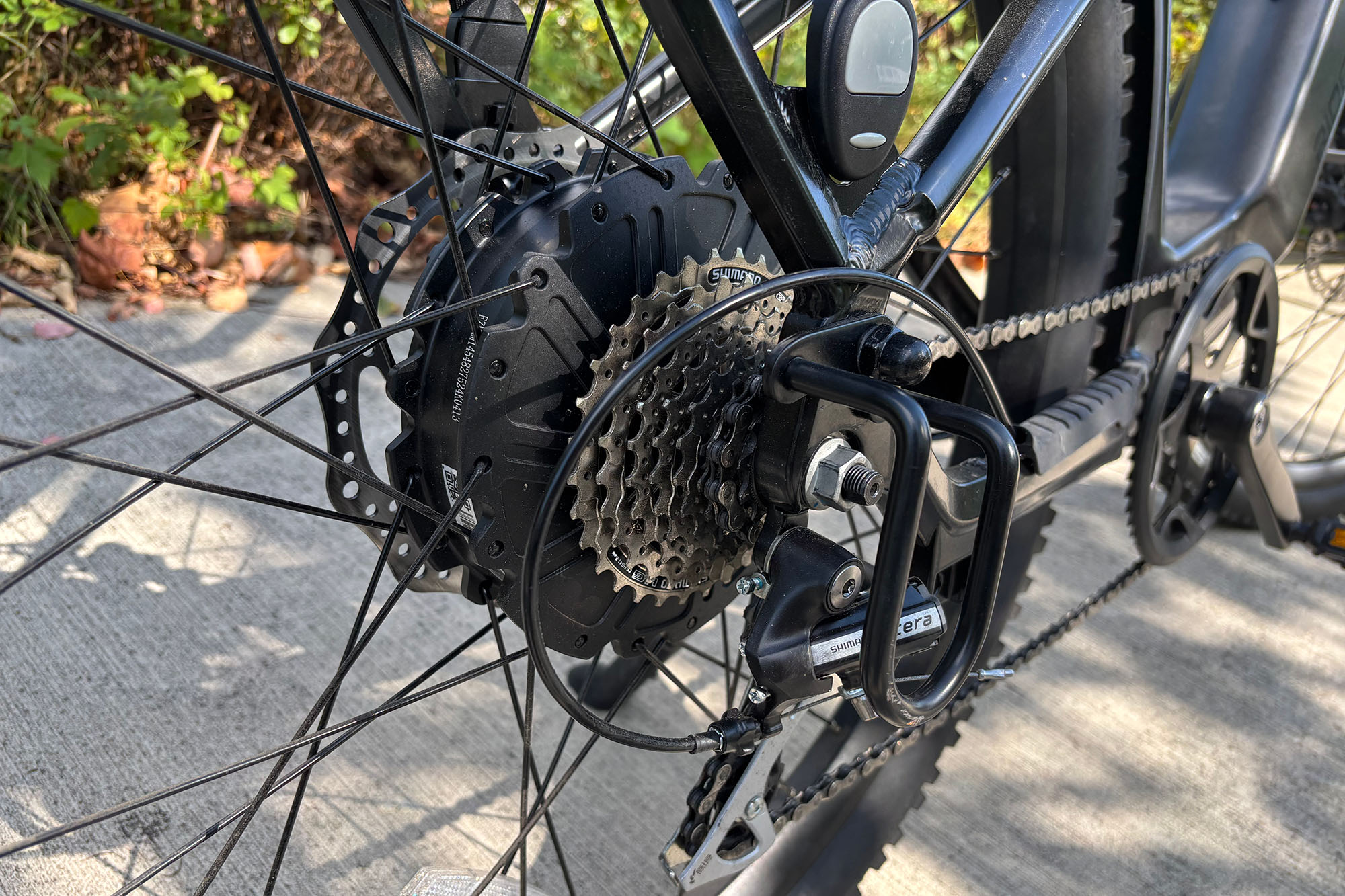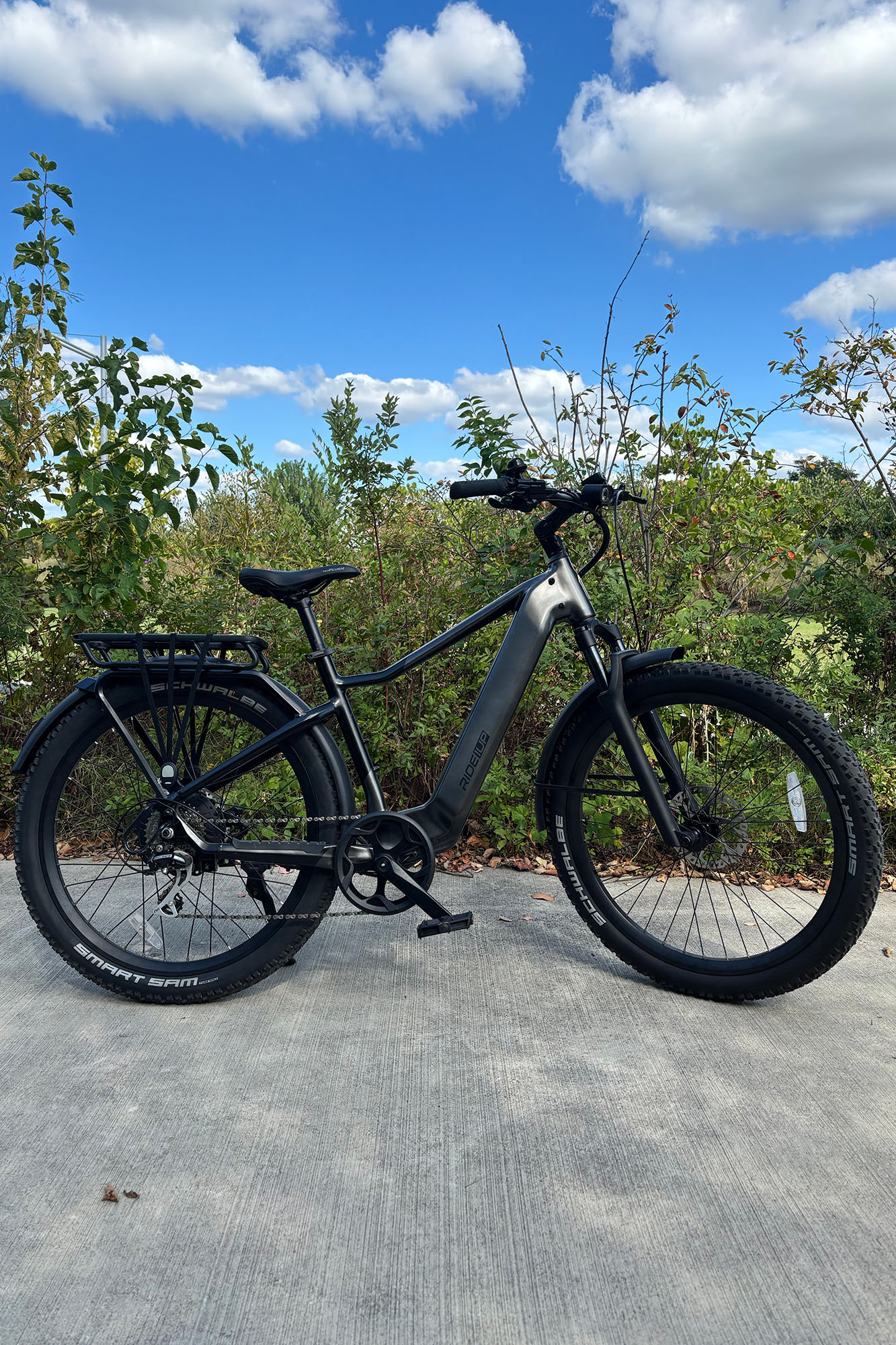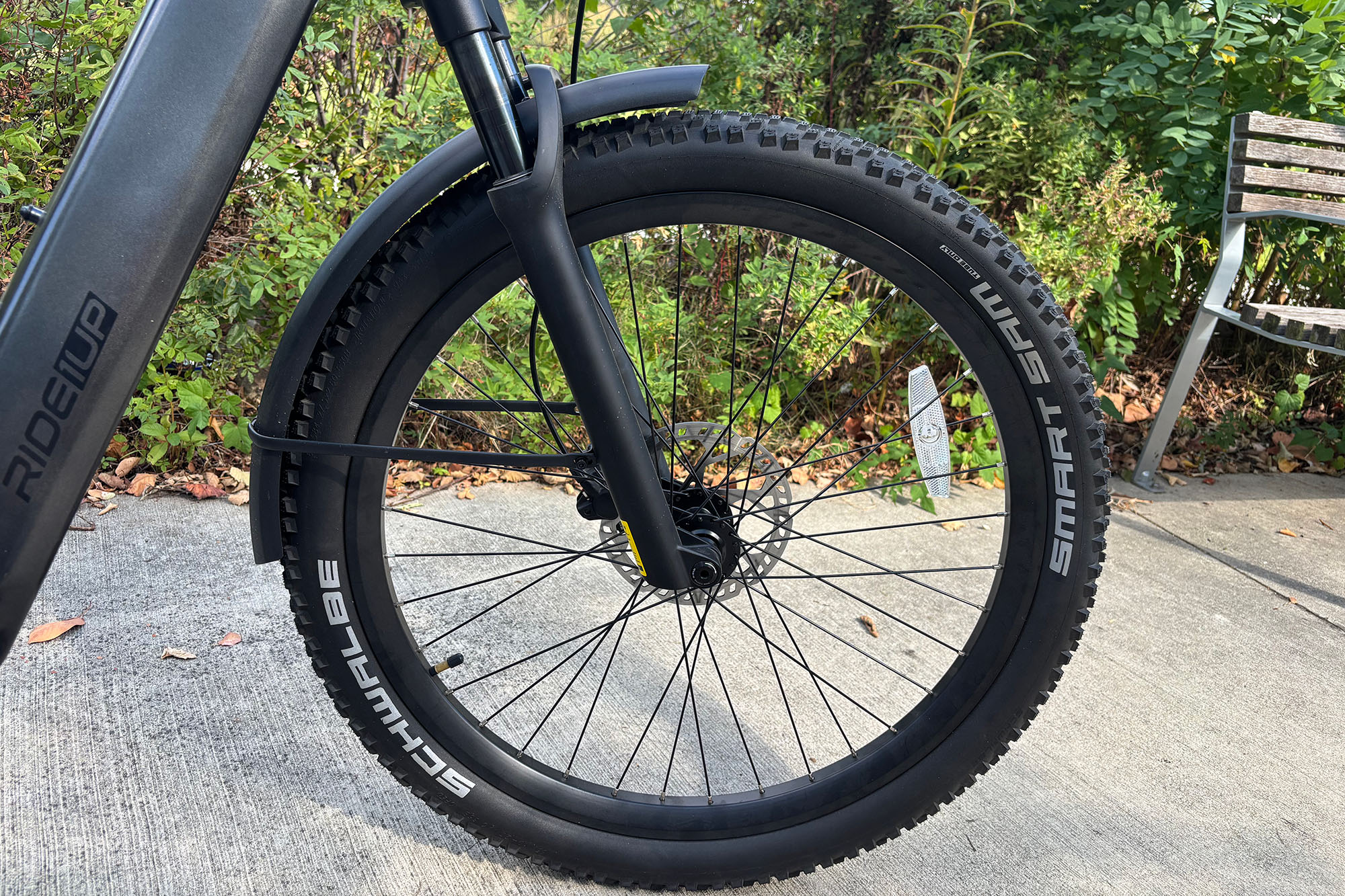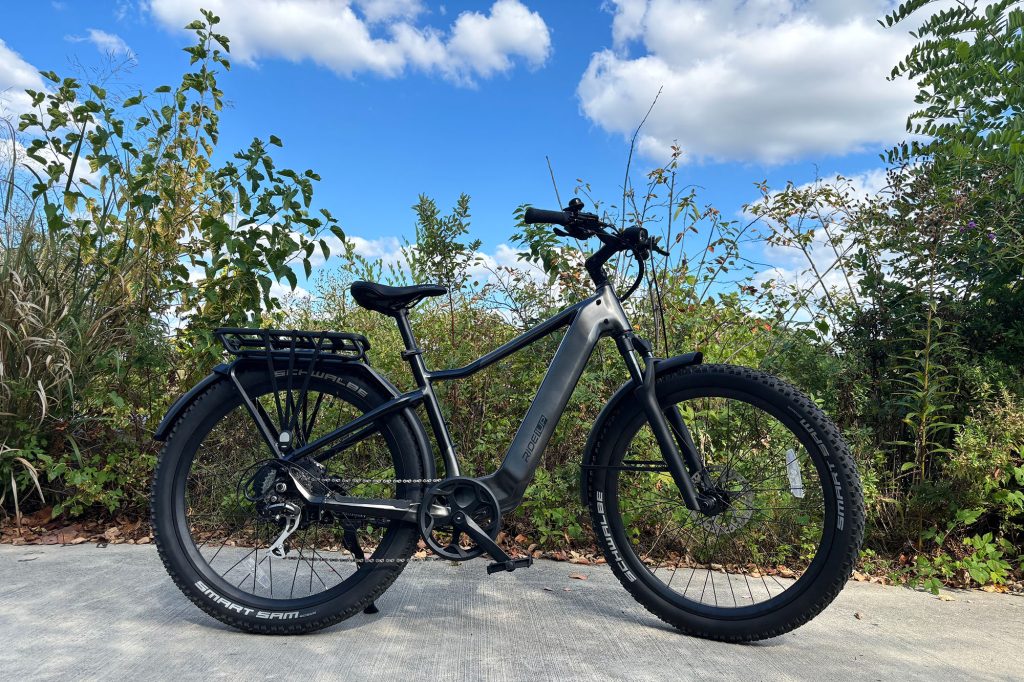The Ride1Up Vorsa couldn’t be more dad if it wore a pair of Nike Air Monarchs and cornered you about proper lawnmowing technique. And I mean that lovingly. This electric bike radiates peak dad energy: practical, dependable, and does a little bit of everything.
Ride1Up calls it the “SUV of e-bikes,” and, frankly, that’s spot-on. At $1,595, it’s not the flashiest thing on two wheels, but it’s built to carry you, your kid, and your Costco haul without breaking a sweat. With a 440-pound carrying capacity and a beefy rear rack, the Vorsa leans into flexibility without the bulk and heft of a full-on cargo bike. It’s a well-rounded, everyday ride: a proper jack of all trades.
Ride1Up Vorsa
Pros
- Switch between Class 1, 2, and 3, and off-road mode
- Programmable PAS level accessed through color display with Apple Find My and USB-C charging port
- Dual-sensor system with Ride1Up Intui-Drive torque and R1CBC cadence sensor
- 100 Lux front light with brake-light activated, fender-integrated rear light
- Fenders included
- Comfortable geometry
- Stable handling
- High carrying capacity with an optional rear rack that supports 150 pounds
- Available in step-through and step-over frames to accommodate a broader range of heights
Cons
- Can feel unwieldy for smaller riders
- Assembly may be better suited for the mechanically inclined
- Nubby tires trade some speed for versatility
- Solid for many types of ride, but not the best at any single category
Specs
-
Motor:
750w AKM rear hub -
Torque:
95Nm -
Battery:
UL 2849 and 2271 Certified 15Ah Samsung GB50 -
Removable Battery:
Yes, lockable -
Riding Range:
Up to 60 miles -
Top Speed:
Class 1 and 2: 20 mph, Class 3: 28 mph, Off-road: 28 mph+ -
Throttle:
Yes -
Suspension:
100mm front suspension fork -
Drivetrain:
Shimano Acera 8-speed trigger shifter -
Brake System:
Star Union hydraulic disc brakes -
Tires:
Schwalbe Smart Sam 27.5-inch x 2.6-inch -
Bike Weight:
65 pounds, but around 70 pounds with the optional rear rack and fenders -
Carrying Weight:
440 pounds -
Connectivity:
Apple Find My
How we tested the Ride1Up Vorsa
The Vorsa comes in two frame styles: a step-thru that fits riders from 5’1″ to 5’11” and a step-over designed for riders between 5’5″ and 6’4″. I tested the step-over, but I’m on the small side of the range, so I also recruited a few taller friends to see if we had different impressions. Together, we put on our favorite electric bike accessories and put the Vorsa through its paces on daily errands, grocery runs, and longer weekend rides.
The design
At first glance, the Vorsa looks like a lot of other e-bikes, with an upright riding position, a wide Velo saddle, and a front suspension fork. The bike alone weighs about 65 pounds, and with the optional fender and rear rack, it creeps closer to 70—fairly standard for a bike with these features. Whether you think that’s heavy depends on what you’re shopping for. For a daily commuter, that may feel like too much weight, but if you’re considering a cargo bike, that’s downright light.
The Vorsa’s mostly upright position is gentle on your neck, shoulders, and wrists, and an adjustable stem helps dial in the fit. The roomy frame favors comfort over corner-carving thrills. Taller riders, in particular, will appreciate not feeling crammed into a clown car. It’s not flashy, but neither is a Honda CR-V—and both get the job done every time. The bike comes in three metallic colorways: glacier blue, sage green, and slate gray.
The rear rack unlocks much of the Vorsa’s practicality. It ships with a triple-strapped elastic bungee—basically the e-bike version of duct tape—handy for strapping down a jacket, U-lock, or odd-shaped package. The rack also ties into Ride1Up’s Connect+ accessory system, so you can add an easily integrated passenger seat, pet carrier, cooler, or rack extension, turning the Vorsa into whatever your weekday demands or weekend deserves.
As a direct-to-consumer brand, Ride1Up ships the bike straight to your door with packaging that doubles as a bike stand and the tools you’ll need for setup. Getting it out of the box is a two-person job. Ride1Up’s explainer videos provide most of the guidance—a good thing, since paper instructions are sparse. And while the bike arrives mostly complete, the final steps include installing the suspension fork, stem, handlebars, pedals, optional fender, and the front wheel with its brake line. These are essential components, so if that sounds intimidating, look for a local bike shop that will handle assembling e-bikes. While it’s an extra fee, it saves you from discovering what “slightly misaligned steering” feels like on the road.

The ride
Before I ever got on my Vorsa, I had high expectations because of a random encounter on our local rail trail. An ebike enthusiast struck up a conversation about a bike I was riding at the time (not a Ride1Up, I’m afraid), and I noticed he was already on a Vorsa. So I asked him about it, and he said it was a great bike for when, as a larger guy, he wanted to get out and stay out, but maybe he didn’t have the legs to match his ambitions.
Much like an SUV, the Vorsa packs a surprisingly big engine, but that power goes more to hauling than taking off like a rocket. The 750W AKM rear hub motor delivers 95 Nm of torque, and while I’m not usually a throttle person, hitting it on a climb feels like activating a cheat code. Push down the thumb throttle, and you’re gliding up the hill without breaking a sweat.
You can set the Vorsa to Class 1, 2, or 3 modes for regular riding, or flip into an off-road setting that pushes it past the 28 mph ceiling. Knowing which class you’re riding in isn’t just trivia; it matters for where you can legally take the bike. Many states limit Class 3 bikes (28 mph) to certain roads or paths, while Class 1 and 2 are allowed on more trails. Being able to change classes means you can stay compliant when needed, then unlock the extra speed when you’re on open roads or private property.
At 65 pounds (closer to 70 with rack and fenders), the Vorsa isn’t light. As a smaller rider, I found my sweet spot in Tour mode, the second pedal-assist level, which gave steady, natural-feeling help thanks to the dual-sensor system that combines an Intui-Drive torque sensor with an R1CBC cadence sensor. I noticed the heft of the bike when climbing hills in lower assist levels, but the eight speeds are ample to flatten things out, plus gravity pays you back on the downhills.
Bigger, taller friends didn’t note this as much; in fact, one liked it so much after a 30-mile summer ride that he bought his own e-bike the same week. His wife keeps texting me updates on his renewed interest/borderline obsession with bikes, and I think I’m supposed to apologize. (I haven’t yet.)
The five assist levels—Eco, Tour, Sport, Turbo, and Boost—offer plenty of options, though the colorful display lets you fine-tune both the amp and torque of each level to your personal preference. Handling is steady and reassuring, like a good commuter car. Wide handlebars give you plenty of leverage, while the Schwalbe Smart Sam 27.5 x 2.6-inch tires provide grip and versatility for gravel paths, grass, and light trails. Paired with a 100mm suspension fork, the ride is cushioned enough to take most of the oomph out of bumps and roots.
My husband fractured his clavicle in early July, and the Vorsa is firmly grounded with enough give to be his back-in-the-saddle bike while he gauges how much road chatter he can handle on the way to his preferred more aggressive, less forgiving geometry. If you only ride on pavement, you might want faster-rolling tires, but the stock setup makes it easy to veer off onto dirt or grass when the mood strikes (or sudden bottlenecks on a crowded path demand).
The lockable, removable 15Ah Samsung GB50 battery (UL 2849 and 2271 certified) is tough to kill. I attempted the task on the highest Boost setting, which is usually how manufacturers determine the short end of the range. My son’s smaller-capacity e-bike tapped out at 22 miles. I kept going, literally riding into the sunset, and popping on the lights so I could see my way home. I finally called it at night after 49.54 mixed-terrain miles and with 27% of the battery left. Usually, published ranges are overly generous, but this is one time that the manufacturer seems to be underselling how far the bike can go. There have been plenty of short trips that barely sip, and longer attempts to completely deplete the battery where we’ve run out of time before we ran out of power. There are people out there reporting 80 miles on Eco and flat, steady paths. The motor system has definitely been optimized.


So, who should buy the Ride1Up Vorsa?
The Vorsa is for riders who want one bike that can do a little bit of everything. This model is especially well-suited to average-to-bigger riders who often feel cramped on standard frames, and to anyone who values stability and comfort over flash. With a generous weight capacity and a full lineup of accessories, it’s versatile, but the real draw is how approachable it feels: steady when you need it, powerful when you want it.
The Ride1Up Vorsa isn’t a bike that cares about fitting neatly into “commuter,” “cargo,” or “trail” categories. It’s about flexibility. You can go where you want, when you want, and can set it up the way your life needs. School drop-offs, errands, weekend rides with a child (human or furry), even a little off-road detour? The Vorsa says yes. Now, if only it said yes to mowing the lawn for you.


